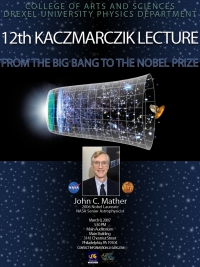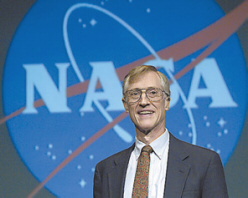12th Kaczmarczik Lecture
"From the Big Bang to the Nobel Prize"
John C. Mather
NASA Goddard Space Flight Center
2006 Nobel Laureate
Thursday, March 8, 2007
3:30 p.m.
Main Building Auditorium
3141 Chestnut Street
Philadelphia, PA 19104
 The history of the universe in a nutshell, from the Big Bang to now, and on to the future - John Mather will tell the story of how we got here, how the Universe began with a Big Bang, how it could have produced an Earth where sentient beings can live, and how those beings are discovering their history. Mather was Project Scientist for NASA's Cosmic Background Explorer (COBE) satellite, which measured the spectrum (the color) of the heat radiation from the Big Bang, discovered hot and cold spots in that radiation, and hunted for the first objects that formed after the great explosion. He will explain Einstein's biggest mistake, show how Edwin Hubble discovered the expansion of the universe, how the COBE mission was built, and how the COBE data support the Big Bang theory. He will also show NASA's plans for the next great telescope in space, the James Webb Space Telescope. It will look even farther back in time than the Hubble Space Telescope, and will look inside the dusty cocoons where stars and planets are being born today. Planned for launch in 2013, it may lead to another Nobel prize for some lucky observer.
The history of the universe in a nutshell, from the Big Bang to now, and on to the future - John Mather will tell the story of how we got here, how the Universe began with a Big Bang, how it could have produced an Earth where sentient beings can live, and how those beings are discovering their history. Mather was Project Scientist for NASA's Cosmic Background Explorer (COBE) satellite, which measured the spectrum (the color) of the heat radiation from the Big Bang, discovered hot and cold spots in that radiation, and hunted for the first objects that formed after the great explosion. He will explain Einstein's biggest mistake, show how Edwin Hubble discovered the expansion of the universe, how the COBE mission was built, and how the COBE data support the Big Bang theory. He will also show NASA's plans for the next great telescope in space, the James Webb Space Telescope. It will look even farther back in time than the Hubble Space Telescope, and will look inside the dusty cocoons where stars and planets are being born today. Planned for launch in 2013, it may lead to another Nobel prize for some lucky observer.
 John C. Mather, PhD, is a Senior Astrophysicist in the Observational Cosmology Laboratory at NASA's Goddard Space Flight Center. His research centers on infrared astronomy and cosmology. As an NRC postdoctoral fellow at the Goddard Institute for Space Studies (New York City), he led the proposal efforts for the Cosmic Background Explorer (74-76), and came to GSFC to be the Study Scientist (76-88), Project Scientist (88-98), and the Principal Investigator for the Far IR Absolute Spectrophotometer (FIRAS) on COBE. He showed that the cosmic microwave background radiation has a blackbody spectrum within 50 parts per million, confirming the Big Bang theory to extraordinary accuracy. As Senior Project Scientist (95-present) for the James Webb Space Telescope, he leads the science team, and represents scientific interests within the project management. He is the recipient of many awards, including most recently the Nobel Prize in Physics (2006) with George Smoot, for the COBE work.
John C. Mather, PhD, is a Senior Astrophysicist in the Observational Cosmology Laboratory at NASA's Goddard Space Flight Center. His research centers on infrared astronomy and cosmology. As an NRC postdoctoral fellow at the Goddard Institute for Space Studies (New York City), he led the proposal efforts for the Cosmic Background Explorer (74-76), and came to GSFC to be the Study Scientist (76-88), Project Scientist (88-98), and the Principal Investigator for the Far IR Absolute Spectrophotometer (FIRAS) on COBE. He showed that the cosmic microwave background radiation has a blackbody spectrum within 50 parts per million, confirming the Big Bang theory to extraordinary accuracy. As Senior Project Scientist (95-present) for the James Webb Space Telescope, he leads the science team, and represents scientific interests within the project management. He is the recipient of many awards, including most recently the Nobel Prize in Physics (2006) with George Smoot, for the COBE work.
High School Open House Program:
12:30 - 1:00 p.m. Main Building Auditorium
1:00 - 3:00 p.m. Department of Physics Open House
Brief presentations on Biophysics, Astrophysics, Computational Physics, Condensed Matter, Nonlinear Dynamics, Particle Physics, etc. An excellent opportunity for high school students to visit our laboratories and meet in person with our internationally recognized researchers.
3:00 - 3:30 p.m. Reception
About the Kaczmarczik Lecture
Paul Kaczmarczik began his career as a Professor of Physics at Drexel University in 1953. A key player in building the Physics and Atmospheric Science Department, he made important contributions to teaching at Drexel University during his many years of service. Well-liked by both his colleagues and his students, Professor Kaczmarczik became Professor Emeritus in 1989. The Kaczmarczik Lecture Series was established in 1995 in honor of Professor Kaczmarczik. It brings to Drexel outstanding scientists to present lectures on topics at the cutting edge of Physics research.